Peer-peviewed by Plant Health Progress
© 2005 Plant Management Network.
Accepted for publication 17 October 2005. Published 21 December 2005.
Randy C. Ploetz, Tropical Research & Education Center, University of Florida, 18905 SW 280th Street, Homestead 33031-3314
Corresponding author: Randy C. Ploetz. rcp@ifas.ufl.edu
Ploetz, R. C. 2005. Panama disease, an old nemesis rears its ugly head: Part 1, the beginnings of the banana export trades. Online. Plant Health Progress doi:10.1094/PHP-2005-1221-01-RV.

Introduction
Banana and plantain (a type of banana) are the most important agricultural products in the tropics. Over 100 million metric tons of fruit are produced annually and that which enters international commerce is worth $5 billion per year (2,13). Locally consumed fruit are major staple foods in sub-Saharan Africa and Latin America, and in countries such as Rwanda and Uganda, per capita consumption approaches 1 kg/day.
Diseases are major constraints in the production of this important crop (15,34,35). They affect every organ of the plant and are caused by fungi, bacteria, viruses and nematodes. They reduce yield; affect the appearance, shelf life, and marketability of harvested fruit; debilitate the host plant; and, in the case of systemic vascular wilts, kill plants.
Panama disease (fusarium wilt) is the most significant vascular wilt of banana (21,23,32,33). Interested readers are referred to an earlier article in Plant Health Progress in which the disease’s distribution, symptoms, cause, epidemiology and management are discussed (23). The destruction that Panama disease caused in the early export trades is a prime example of the risks that are inherent in the use of crop monocultures. These epidemics also demonstrated the profound influence a plant disease can have on local and regional communities. Where economies were based largely on export bananas, Panama disease caused financial hardship, unemployment, displacement, and social and political unrest (18,34).
Early History
This review is divided into two parts. In this first article, a summary is given of how and where the banana export trades began, the early history of Panama disease, and the important effect that the disease had on the development of this industry. This is a story of political and social upheaval, and of the first large agriculture ventures in the tropics. It focuses on the trades in the Americas before they converted to the resistant Cavendish cultivars. Diverse banana cultivars are affected by Panama disease, but the early work to understand the disease and its causal fungus, Fusarium oxysporum f. sp. cubense (FOC), focused almost entirely on the American export situation and the susceptible cultivar with which it started, ‘Gros Michel’ (32). The trades’ dependence on ‘Gros Michel’ would have been fatal were it not for the Cavendish cultivars. The transition from ‘Gros Michel’ to Cavendish started in the mid-1900s and was a major undertaking. Directly and indirectly, Panama disease changed the ways in which this multinational business produced and marketed its product. In addition to the massive replanting effort that this entailed, Cavendish fruit required different, far gentler measures for harvesting, handling, and shipping than were used for ‘Gros Michel’ (Figs. 1 through 10).
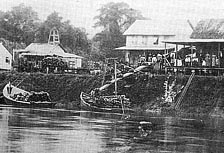 |
|
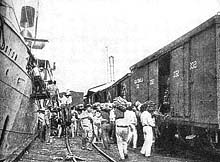 |
|
Fig. 1. Shipment of ‘Gros Michel’ bunches on the Cricamola River, Panama, in 1894. Note railroad siding that runs parallel to the river (published in ref. 31). |
|
Fig. 2. Movement of ‘Gros Michel’ bunches from railroad cars to a waiting steam ship in 1921 (14). |
| |
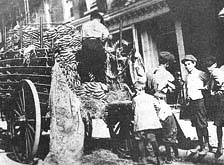 |
|
 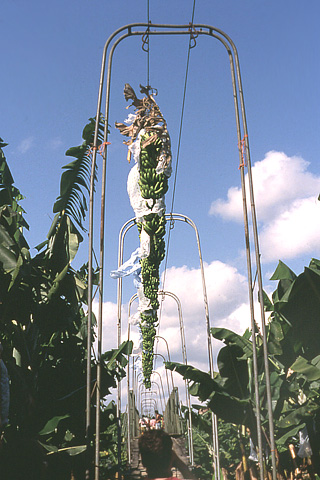
|
|
| |
Fig. 3. Marketing of ‘Gros Michel’ bananas from a wagon in the U.S. (14). Note in Figs. 1 through 3 that fruit of ‘Gros Michel’ was not removed from the bunch until it was sold to the consumer. |
|
Fig. 4. Transport of bunches of ‘Grand Nain’ (a Cavendish cultivar) from the field on cableways in a modern export plantation in Costa Rica (photo courtesy of R. C. Ploetz). |
|
| |
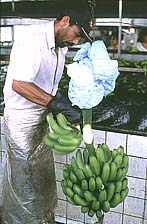 |
|
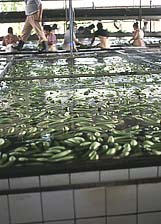 |
|
|
| |
Fig. 5. Removal of individual hands of fruit from a bunch of ‘Grand Nain’ that has reached the packing plant (photo courtesy of R. C. Ploetz). |
|
Fig. 6. Delatexing tanks in which hands are placed immediately after removal from the bunch. Since latex that exudes from the cut crown of the hand can damage fruit cosmetically, it is important that it be removed in such water baths (photo courtesy of R. C. Ploetz). |
|
| |
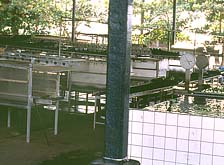 |
|
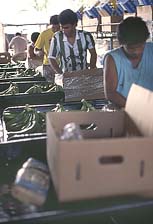 |
|
| |
Fig. 7. |
|
Fig. 8. |
|
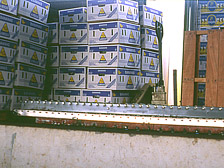 |
|
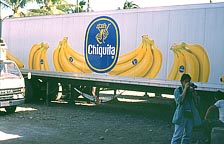 |
|
Fig. 9. |
|
Fig. 10. |
After hands have been delatexed (Fig. 7.; note baths on the right), they are sprayed with a post-harvest fungicide (Fig. 7.; note conveyor belts on the left). Fungicide-treated hands are then boxed (Fig. 8), palletized (Fig. 9), and moved to refrigerated trucks (Fig. 10) and ultimately ships (photos courtesy of R. C. Ploetz). Usually, less than 48 hours elapse from harvest to when fruit departs the shipping ports. In Figs. 4 through 10, note the far more laborious post-harvest handling that is required for Cavendish fruit versus that in Figs. 1 through 3 that was used for ‘Gros Michel’ fruit.
Recent Events
In the second part of this review, forthcoming in Plant Health Progress, the impact of Panama disease outside the trades will be discussed. Throughout the tropics, preferred banana cultivars can no longer be grown due to this disease (20,22,23,24,32). Difficulties that the banana improvement programs have faced when producing new, resistant genotypes will be outlined, as will conventional and nonconventional approaches to improvement.
Part two of this review ends with commentary on two recent surprises. The trades are still based on Cavendish cultivars that were used to replace ‘Gros Michel.’ Since they have been grown successfully for decades in the same soils that were used to produce ‘Gros Michel,’ it had been presumed that the Cavendish clones were highly resistant (8). This illusion was shattered in the early 1990s. Serious outbreaks of Panama disease developed in Sumatra and peninsular Malaysia in Cavendish plantations that had been planted for Middle Eastern and Japanese markets (24,25). In these and now several other locations in Southeast Asia, Cavendish has proven to be as susceptible as was ‘Gros Michel’ decades before in the American epidemics.
A new variant of FOC, tropical race 4 (TR4), is responsible for the Southeast Asian outbreaks (24,25). Unlike subtropical outbreaks that affect cold-stressed Cavendish in Australia, the Canary Islands, and South Africa, TR4 affects Cavendish in the absence of predisposing factors. Although it is found only in Southeast Asia, TR4 continues to spread in that region. The great fear is that it will spread to the Americas and Africa where it could have a great impact on the production of export bananas and plantains that normally resist Panama disease. TR4 poses a serious threat to a multibillion dollar industry and the food stability of millions of poor farmers.
In another development, phylogenetic work on FOC has revealed that it has had at least three independent evolutionary origins (17,19). Different clades of the pathogen are distantly related, and one is more closely related to members of another forma specialis, F. oxysporum f. sp. melonis, than to other clades of FOC. Although many formae speciales of F. oxysporum are now known to be phylogenetically diverse (4), the original work on FOC was revolutionary in that it challenged, for the first time, assumptions that strains within a form of F. oxysporum were closely related.
The Banana Export Trades
Export commerce in dessert bananas began in the early 1800s (14,28). Initially, fruit was produced in the Caribbean and shipped to the USA. For example, New York City received 30 bunches of red bananas from Cuba in 1804, and a far larger consignment, 1,500 bunches, from the Caribbean in 1830. These early shipments were quite risky since the sailing ships that were used were slow, depended heavily on favorable winds, and were not adapted to shipping such a perishable commodity (Fig. 11). It was not uncommon for entire loads of fruit to be lost (ripen) before they reached their destination. Conditions in the producing countries were even more primitive. Harvested fruit were moved out of the fields by hand or horseback, and transport to ports was on rivers or poor roads; railroads did not exist.
| |
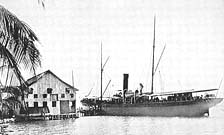
Fig. 11. The S.S. Bowden, the first banana steam ship (plate 60 in ref. 28). |
|
Slowly these conditions improved (14,28). Roads and aerial cableways were added to plantations, railroads were built that connected plantations with ports, and faster and more reliable steam ships replaced the original sailing vessels. Expanded markets for this commodity followed improvements in fruit transport. Banana was first shipped inland (further than port cities) in the 1880s and to a country other than the USA (England) in 1896 (28). By the turn of the century, the American trades were well established. Large-scale production occurred in the Caribbean and Central and South America, and far-flung markets developed. Fruit quantities and quality increased and prices decreased to the extent that by 1905 bananas had changed from a luxury to "the poor man’s fruit" (14).
The most notable and successful of the early banana barons was Minor Keith (18,28) (Fig. 12). He began to build railroads in Costa Rica in 1871, and alongside these lines he planted bananas (Figs. 13). A highly ambitious individual, Keith married the daughter of the President of Costa Rica and, as his banana and railroad ventures prospered, was named "The Uncrowned King of Central America."
| |
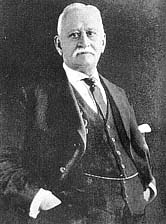 |
|
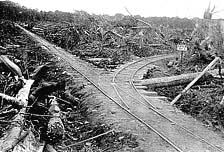 |
|
| |
Fig. 12. Minor C. Keith, the first highly successful banana planter in Central America (plate 62 in ref. 28). |
|
Fig. 13. A new banana planting along tracks of a new rail line in Costa Rica in the late 1800s (Fig. 8, pg. 22 in ref. 36). |
|
The early banana plantations were hewn out of virgin rainforest and were planted on well-drained, alluvial soils (Figs. 14 and 15). The infestation of prime banana soils with FOC and the scarcity of these soils that developed became deciding factors in the eventual abandonment of ‘Gros Michel.’ However, it would be several decades before this occurred. In the meantime, the ‘Gros Michel’-based trades remained highly profitable.
| |
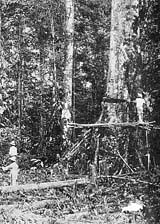 |
|
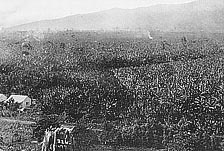 |
|
| |
Fig. 14. Removal of tropical rainforest in Costa Rica to prepare for banana cultivation (Fig. 6, pg. 20 in ref. 36). |
|
Fig. 15. A new monoculture of ‘Gros Michel’ planted on land that was formerly covered in dense rainforest (Fig. 9, pg. 23 in ref. 36). |
|
In many of the producing countries, banana became a primary source of export revenue. The crop became such a dominant economic force that the producing companies began to influence the internal affairs of several countries, the so-called "Banana Republics" (18). The United Fruit Company, of which Minor Keith was a founder, was especially notorious for meddling in national politics. In the worst cases, democratically elected presidents who opposed the company were replaced in coups by puppet dictators. Police and military forces were directed to quell labor riots and diffuse any activity that ran counter to the company’s interests. Where work forces threatened to unionize, the company shut down operations and dismantled the associated communities.
Although the trades corrupted governments and caused considerable social upheaval and hardship, they also had a positive impact. They dramatically improved transportation and shipping infrastructure in the western tropics. They were major employers who paid relatively high wages. They provided decent homes, schools, and hospitals for their employees, and initiated aggressive programs to combat malaria, dengue fever, and other tropical diseases. Despite their unsavory reputation in many quarters, the trades improved the lives of many.
Impact of Panama Disease
The first trades relied almost entirely on ‘Gros Michel’ (28,32). In many ways, ‘Gros Michel’ is an ideal export banana. It produces massive bunches of large, flavorful fruit that are so resistant to mechanical damage that they could be shipped intact (Figs. 1 to 3). The downfall of ‘Gros Michel’ was its extreme susceptibility to Panama disease.
Panama disease was first reported in Australia, but became most important in the monocultures of ‘Gros Michel’ that were used by the trades in the Western Hemisphere (22,32). Panama was one of the first countries to experience major epidemics. It caused staggering losses in the trades before production areas converted to Cavendish. Between 1940 and 1960, 30,000 ha were lost in the Ulua Valley of Honduras, and in a decade complete losses were recorded in operations of 4,000 ha in Suriname and 6,000 ha in the Quepos area in Costa Rica. If one compiles figures up to 1960 and considers the substantial costs that were associated with plantation establishment, losses of approximately $400,000,000 can be attributed to Panama disease. Using a conservative conversion rate, this would be at least $2.3 billion in 2000 figures, and would be even greater if costs were included for unemployment, abandoned villages, unrealized income, and expenditures to maintain social stability in the affected regions.
Early Research
In a first report in 1876, J. Bancroft (5) speculated that a fungus caused the disease based on his microscopic examinations of affected tissue. He also recognized that healthy looking suckers could harbor the disease and recommended that suckers be inspected internally for symptoms before they were used to establish new fields. In 1904, J. E. Higgins (12), unaware of Bancroft’s work in Australia, proposed that a fungus caused the disease in Hawaii.
In 1910, E. F. Smith became the first person to isolate the pathogen from banana tissues he received from Cuba (Fig. 16). Based on symptoms that had been reported elsewhere, he suggested that the disease was also present in Central America, Jamaica, and Suriname (29). Smith recognized that the isolated fungus was in the genus Fusarium, and due to its Cuban source named it F. cubense. (Smith’s results were reported in the proceedings of the first APS meeting, held in Boston in 1908.) It was another decade before Koch’s postulates were completed with F. cubense.
| |
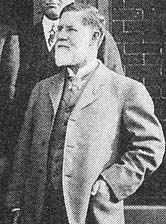
Fig. 16. Erwin F. Smith, distinguished early plant pathologist (Fig. 3.12, pg. 153 in ref. 9). |
|
Brandes (6) summarized prior studies on the disease and pathogen, and reported results from diverse field and lab experiments (Fig. 17). External and internal symptoms of the disease were illustrated in the paper with color photographs, which were uncommon for the time (Figs. 18 and 19). Brandes probably worked with race 2 of the pathogen since the race 2 differential cultivar ‘Chamalucco’ (a.k.a. ‘Bluggoe’) was used. The first person to work with race 1 (the race that affected ‘Gros Michel’) was probably Carleton (10) in 1922. During the ensuing decades, almost all first reports of the disease from a given country or location were on ‘Gros Michel’ (Fig. 20).
| |
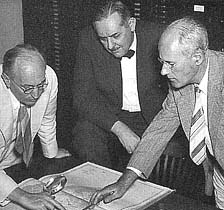
Fig. 17. E. W. Brandes (center), the first person to demonstrate conclusively that "Fusarium cubense" caused Panama disease (figure in ref. 11). In the picture, Brandes discusses sources of natural rubber in South America during World War II when extensive plantations of that crop in Indonesia were controlled by the Japanese. After his Ph.D. work on Panama disease, Brandes became an expert on tropical crops, particularly sugarcane (3,7). |
|
| |
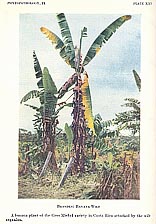
Fig. 18. |
|
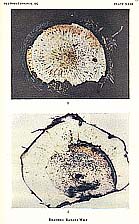
Fig. 19. |
|
| |
External (Fig. 18) and internal (Fig. 19) symptoms of Panama disease. These photos were published in Brandes’ (6) definitive article on Panama disease in Phytopathology in 1919. |
|
| |
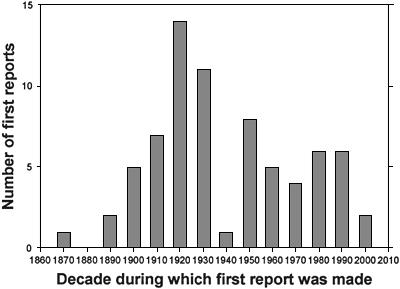
Fig. 20. Total numbers of first reports from countries or major-banana growing regions during the decades 1870 to 2000. Data are from refs. 1, 21, 23, 24, 26, 27 and 32. |
|
In 1935 H. W. Wollenweber (Fig. 21) and O. A. Reinking (38) recognized that F. cubense was a variant of the ubiquitous F. oxysporum. In 1940, their F. oxysporum variety cubense (Fig. 22) became F. oxysporum f. sp. cubense when W. C. Snyder and E. W. Hansen (Figs. 23 and 24) (30) created special forms, formae speciales, to classify plant-pathogenic strains of F. oxysporum that affected closely related host taxa. Although it is now clear that Snyder and Hansen oversimplified what Wollenweber (37) called "the Fusarium problem" (16), their special form concept was a useful way to categorize the numerous wilt forms of this morphologically defined species.
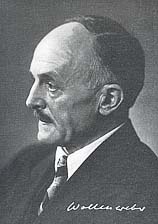 |
|
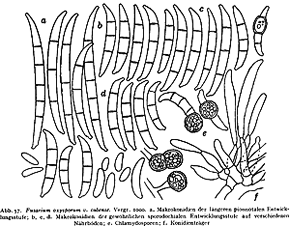 |
|
Fig. 21. Hans Wilhelm Wollenweber, early German authority on the genus Fusarium. |
|
Fig. 22. Line drawing of Fusarium oxysporum variety cubense that appeared in Wollenweber and Reinking’s 1935 monograph (38). |
| |
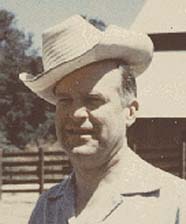 |
|
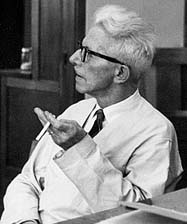 |
|
| |
Fig. 23. |
|
Fig. 24. |
|
W. (Bill) C. Snyder (Fig. 23) and H. N. Hansen (Fig. 24), seminal figures in the taxonomy of Fusarium oxysporum and originators of the forma speciales concept for delineating plant-pathogenic populations of this morphospecies.
As the end of the ‘Gros Michel’ era neared, a Canadian made significant contributions to our understanding of the disease and FOC. Shortly after R. H. Stover obtained his Ph.D. in 1950 he was hired by the United Fruit Company to devise management strategies for Panama disease (Fig. 25). By that time, Panama disease threatened the very existence of the export trades. Losses were widespread and severe, most first-class banana soils were infested and could not be replanted successfully with ‘Gros Michel,’ and virgin noninfested land was becoming rare. Stover added new insights into the taxonomy, variation, and physiology of FOC, helped describe its interaction with banana, characterized resistance and susceptibility in banana, studied the influence of edaphic factors on the pathogen, and introduced flood fallowing as a means for cleansing contaminated soil. Stover’s research culminated in a sabbatical at Cambridge University in the laboratory of S. D. Garrett during which he wrote the monograph "Fusarial Wilt (Panama Disease) of Bananas and other Musa Species" (32).
| |
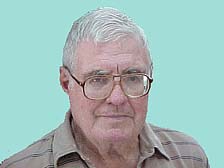
Fig. 25. Robert Harry Stover, an authority on Panama disease for over five decades (photo courtesy of FHIA). |
|
The publication of Stover’s monograph in 1962 coincided with the transition by the trades from ‘Gros Michel’ to the Cavendish cultivars. Despite the great expense that was associated with this change, it had become impossible for the trades to continue using such a susceptible cultivar. With this transition came a dramatic reduction in the amount and types of research that were done on Panama disease. Since Cavendish was not affected, the export companies were no longer concerned about Panama disease and turned their attention to more pressing problems, such as the Sigatoka leaf spots.
A future article will discuss the recent resurgence of interest in Panama disease. What had been dismissed as a problem of the past has now reappeared as a formidable foe.
Literature Cited
1. Anonymous. 1977. Fusarium oxysporum f. sp. cubense, Distribution Maps of Plant Diseases. Map No. 31, ed. 4. CMI, Kew, Surrey, UK.
2. Anonymous. 2005. Statistics databases. Online. Food Agric. Organiz. United Nations (FAO).
3. Artschwager, E., and Brandes, E. W. 1958. Sugarcane (Saccharum officinale L.): Origin, classification, characteristics and descriptions of representative clones. USDA Handbook 122, Washington.
4. Baayen, R. P., O’Donnell, K., Bonants, P. J. M., Cigelnik, E., Kroon, L. P. N. M., Roebroeck, E. J. A., and Waalwijk, C. 2000. Gene genealogies and AFLP analyses in the Fusarium oxysporum complex identify monophyletic and nonmonophyletic formae speciales causing wilt and rot disease. Phytopathology 90:891-900.
5. Bancroft, J. 1876. Report of the board appointed to enquire into the cause of disease affecting livestock and plants. Queensland, 1876. Votes and Proceedings 1877:1011-1038.
6. Brandes, E. W. 1919. Banana wilt. Phytopathology 9:339-389.
7. Brandes, E. W. 1929. Into primeval Papua by seaplane: Seeking disease-resisting sugar cane, scientists find Neolithic Man in unmapped nooks of sorcery and cannibalism. Nat. Geog. 56:253-332.
8. Buddenhagen, I. W. 1990. Banana breeding and Fusarium wilt. Pages 107-113 in: Fusarium Wilt of Banana. R. C. Ploetz, ed. American Phytopathological Society, St. Paul, MN.
9. Campbell, C. L., Peterson, P. D., and Griffith, C. S. 1999. The Formative Years of Plant Pathology in the United States. American Phytopathological Society, St. Paul, MN.
10. Carleton, M. A. 1922. Note on the Fusarium wilt disease of bananas. Science 56:663-664.
11. Davis, W. 1997. One River: Explorations and Discoveries in the Amazon Rain Forest. Touchstone. New York.
12. Higgins, J. E. 1904. The Banana in Hawaii. Hawaii Agric. Expt. Stn. Bull. 7.
13. International Network for the Improvement of Banana and Plantain. Online. INIBAP, a program of Consultative Group on Int. Agric. Res. (CGIAR) and Int. Plant Gen. Res. Inst. (IPGRI).
14. Jenkins, V. S. 2000. Bananas: An American History. Smithsonian Institution Press. Washington, DC.
15. Jones, D. R., ed. 2000. Diseases of Banana, Abacá and Enset. CABI Publishing. Wallingford, UK.
16. Kistler, H. C. 2001. Evolution of host specificity in Fusarium oxysporum. Pages 70-82 in: Fusarium. Paul E. Nelson Memorial Symposium. American Phytopathological Society, St. Paul, MN.
17. Koenig, R., Ploetz, R. C., and Kistler, H. C. 1997. Fusarium oxysporum f. sp. cubense consists of a small number of divergent and globally distributed lineages. Phytopathology 87:915-923.
18. Landmeier, P. 1997. Banana republic: The United Fruit Company. Online. Maya Paradise: The Río Dulce, Guatemala info. web site.
19. O’Donnell, K. O., Kistler, H. C., Cigelnik, E., and Ploetz, R. C. 1998. Multiple evolutionary origins of the fungus causing Panama disease of banana: Concordant evidence from nuclear and mitochondrial gene genealogies. Proc. Nat. Acad. Sci. (USA) 95:2044-2049.
20. Pegg, K. G., Moore, N. Y. and Sorensen, S. 1994. Variability in populations of Fusarium oxysporum f. sp. cubense from the Asia/Pacific region. Pages 70-82 in: The Improvement and Testing of Musa: A Global Partnership, Proceedings of the First Global Conference of the International Musa Testing Program held at FHIA, Honduras, 27-30 April 1994. D. R. Jones, ed. INIBAP, Montpellier, France.
21. Ploetz, R. C., ed. 1990. Fusarium Wilt of Banana. American Phytopathological Society, St. Paul, MN.
22. Ploetz, R. C. 1992. Fusarium wilt of banana (Panama disease). Pages 270-282 in: Plant Diseases of International Importance, Vol. III. A. N. Mukhopadhyay, H. S. Chaube, J. Kumar, and U. S. Singh, eds. Prentice Hall, Englewood Cliffs, New Jersey, USA.
23. Ploetz, R. C. 2000. Panama disease: A Classic and Destructive Disease of Banana. Online. Plant Health Progress doi:10.1094/PHP-2000-1204-01-HM.
24. Ploetz, R. C., and Pegg, K. G. 2000. Fusarium wilt. Pages 143-159 in: Diseases of Banana, Abacá and Enset. D. R. Jones, ed. CABI Publishing. Wallingford, UK.
25. Ploetz, R. C., Thomas, J. E., and Slabaugh, W. 2003. Diseases of Banana and Plantain. Pages 73-134 in: Diseases of Tropical Fruit Crops. R. C. Ploetz, ed. CABI Publishing. Wallingford, UK.
26. Shivas, R. G., and Philemon, E. 1996. First record of Fusarium oxysporum f. sp. cubense on banana in Papua New Guinea. Australasian Plant Pathol. 25:260.
27. Shivas, R. G., Suyuko, S., Raga, N., and Hyde, K. D. 1996. Some disease-associated microorganisms on plants in Irian Jaya, Indonesia. Australas. Plant Pathol. 25:36-49.
28. Simmonds, N. W. 1966. Bananas, 2nd ed. Longmans, London, UK.
29. Smith, E. F. 1910. A Cuban banana disease. Science 31:754-755.
30. Snyder, W. C., and Hansen, H. N. 1940. The species concept in Fusarium. Amer. J. Bot. 27:64-67.
31. Stephens, C. S., ed. 1989. Bananeros in Central America. Press Printing Co., Ft. Myers, FL.
32. Stover, R. H. 1962. Fusarial Wilt (Panama Disease) of Bananas and Other Musa Species. CMI, Kew, Surrey, UK.
33. Stover, R. H. 1972. Banana, Plantain, and Abacá Diseases. CMI, Kew, Surrey, UK, 316 pp.
34. Thurston, H. D. 1997. Tropical Plant Diseases. 2nd ed. American Phytopathological Society, St. Paul, MN.
35. Wardlaw, C. W. 1961. Banana Diseases. John Wiley & Sons Inc. New York, NY.
36. Wardlaw, C. W., and Mcquire, L. P. 1929. Panama Disease of Bananas. Empire Marketing Board. His Majesty’s Stationary Office, London.
37. Wollenweber, H. W. 1913. Studies on the Fusarium problem. Phytopathology 3:24-50.
38. Wollenweber, H. W., and Reinking, O. W. 1935. Die Fusarien. Paul Parey. Berlin.
